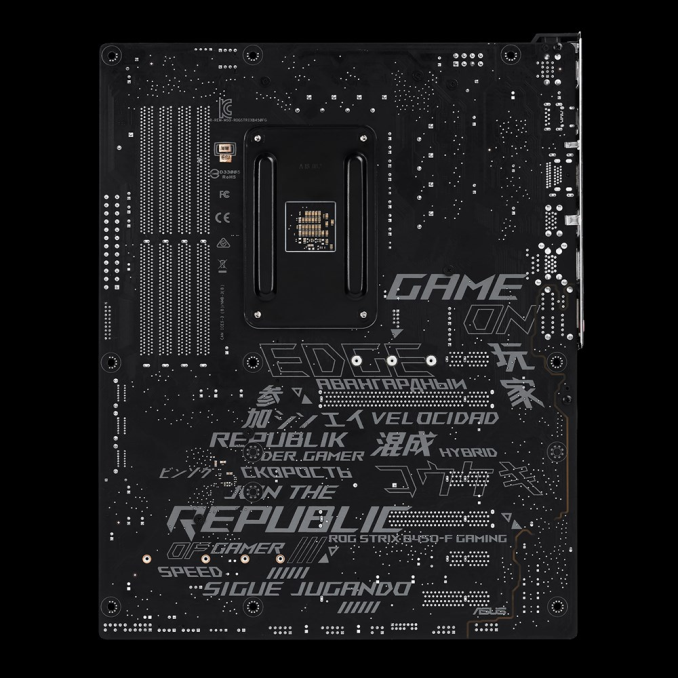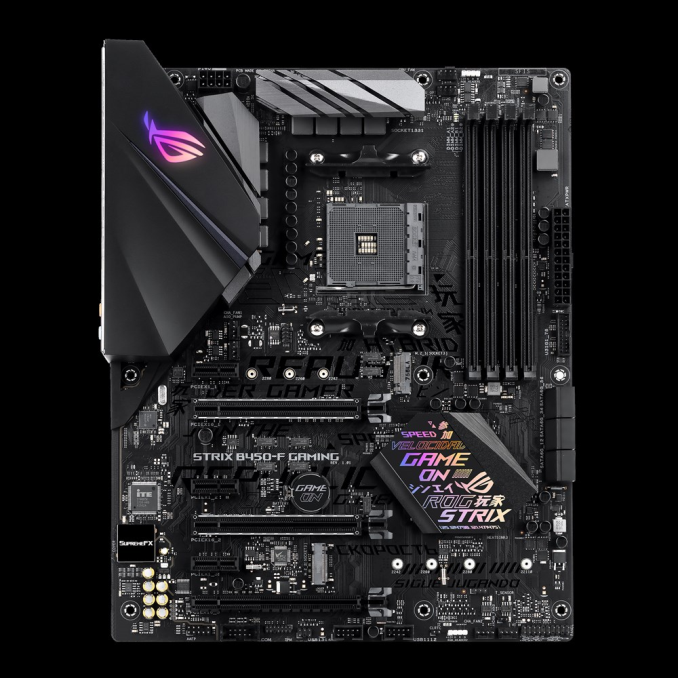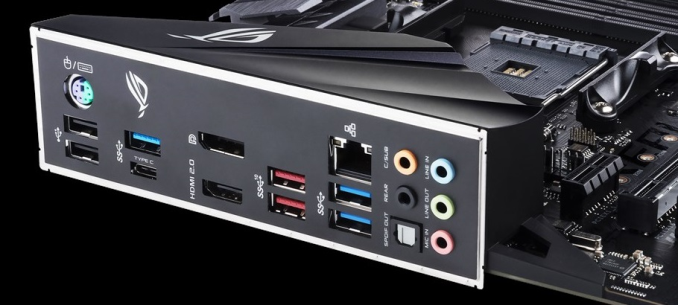Analyzing B450 for AMD Ryzen: A Quick Look at 25+ Motherboards
by Gavin Bonshor on July 31, 2018 8:00 AM ESTASUS ROG Strix B450-F Gaming
Opening up on the ASUS line-up of B450 motherboards, the ROG Strix B450-F Gaming looks to be one of the most premium rich of all the B450 options at launch. The Strix B450-F is a mid-ranged ATX offering with a host of features including a SupremeFX S1220A audio codec, an Intel I211-AT Gigabit networking controller and an HDMI 2.0b output on the rear panel; this is in addition to a Strix DisplayPort 1.2 output to make use of the Ryzen 2000 series APUs featuring Vega graphics. The Strix B450-F has an integrated RGB LED behind the ROG eye on the rear panel cover, with the capability to expand upon this thanks to two included AURA Sync capable RGB headers.
The general theme of the design comes in a different style to ROG themed boards of the past which were generally red and black, with the B450-F Gaming following its own journey with a black and grey contrasting PCB. The biggest focal point of the design is an extravagant looking chipset heatsink which has a futuristic styled ROG Strix sticker. An alternatively designed sticker with the same futuristic text, but with a subtler design will be available in the box.
Following in line with the majority of B450 motherboards, the Strix B450-F Gaming has support for DDR4-3200 memory, with a maximum capacity of 64 GB across the four available RAM slots. A total of six 4-pin headers make up the cooling options which are divided into two CPU fan headers, three regular chassis headers and one dedicated for an AIO or water cooling pump. A further USB 3.1 5 Gbps and four USB 2.0 ports can be opened up by the use of onboard headers and a clear CMOS jumper is also featured on this board instead of a dedicated button.

The ROG Strix B450-F Gaming's uniquely styled PCB on the rear
The ROG Strix B450-F Gaming has two full-length PCIe 3.0 x16 slots which when both slots are populated, operate at x8/x4. With the bottom full-length PCIe 2.0 x4 slot being driven directly from the B450 chipset, it’s possible to run AMD 3-way CrossFire multi-graphics configurations on this particular model. Both the PCIe 3.0 x16 slots feature a wave of ASUS’s SafeSlot metal coating designed to provide the slots with extra protection. The B450-F Gaming also features three PCIe 2.0 x1 slots.
Focusing on power options, the ROG Strix B450-F Gaming looks to feature 8-phase digital power delivery most likely consisting of a 6+2 design. An 8-pin ATX 12 V power input is present to deliver power directly to the CPU, whereas a single 24-pin ATX power input is also present to provide auxiliary power to the board and the rest of the controllers. A metallic silver heatsink covers the MOSFETs and looks rather formidable for a mid-ranged motherboard.
The majority of the storage connectivity on the Strix B450-F Gaming comes through six right-angled SATA 6 Gbps ports with four being driven directly from the B450 chipset. The SATA 6 Gbps ports support different RAID arrays including 0, 1 and 10. Also present is a duo of M.2 slots with both having support for PCIe 3.0 x4 M.2 drives, while the top slot which supports both PCIe and SATA drives up to a size of M.2 2280 (22 x 80 mm), the bottom slot only supports PCIe 3.0 x4 drives with a sizing up to M.2 22110 (22 x 110 mm).
On the rear panel, there are USB connections aplenty with two USB 3.1 10 Gbps ports (in blue), four USB 3.1 5 Gbps Type-A ports (in blue) and two USB 2.0 ports. Also present on the rear panel is five 3.5mm audio jacks an optical S/PDIF output which is powered by the ASUS ROG branded Supreme FX S1220A codec; this is further enhanced through the ASUS Sonic Studio III software. A single LAN port is featured controlled by an Intel I211-AT Gigabit network controller, with a PS/2 combo port and a pairing of video outputs consisting of a DisplayPort and HDMI 2.0 output finishing off the rear. One of the biggest aesthetic changes to the rear panel comes through a black I/O shield which is pre-mounted to the board out of the box.
The ASUS ROG Strix B450-F Gaming as the naming scheme would state, is specifically aimed at gamers looking to make use of premium integrated features such as the SupremeFX S1220A audio codec, but without spending $200+ on a more feature-packed X470 motherboard. The major disadvantage with B450 is the lack of NVIDIA SLI multi-graphics support, but the Strix B450-F is as good looking as they come on paper without spending excessively for unnecessary features. The rear of the PCB is a particular visually pleasing point, although most users won't see this aside from installing the board into their chassis of choice. The ROG Strix B450-F Gaming is set to retail for $129.99 which makes this one of the most expensive, but also feature packed B450 boards at launch.




_thumb.jpg)
_thumb.png)
_thumb.jpg)
_thumb.png)
_thumb.jpg)
_thumb.png)








62 Comments
View All Comments
theanalyzer - Tuesday, July 31, 2018 - link
Signed up to point that out. Needs to be fixed. It’s the only ITX board supporting 2x which sets it’s apart form the competitionDeath666Angel - Tuesday, July 31, 2018 - link
Glad to see more options in the mATX range with two M.2 slots, not just from AsRock this time around. My next rig will either be based on the AsRock B450M Pro4 or one of the MSI B450M Mortar boards. Will wait for actual VRM setup and overclocking results / general tests to see which one will be it. I had motherboards from both manufacturers and was pleased with both. MSI has the advantage of offering PCIe M.2 options for both slots as well as SATA. One question regarding that: if I install a 3.0 PCIe x2 M.2 SSD into a 2.0 PCIe x4 slot, what will be the speed ramifications? Can it only use 2.0 PCIe x2 or can it use the full x4, thus being similar in speed to a native 3.0 PCIe x2 setup? :) Still waiting on mATX x470 mainboards.Outlander_04 - Tuesday, July 31, 2018 - link
.3.0 x 2 is the same speed as 2.0 x 4DanNeely - Tuesday, July 31, 2018 - link
Except that a 3.0 x2 drive is almost certainly x2 because it only has 2 PCIe lanes (cutting down on them is one of the ways the cheaper drives pinch pennies), which means it will be connected at 2.0 x2; at that point you might as well just use a SATA drive and save a bit more money.Death666Angel - Tuesday, July 31, 2018 - link
Thanks for providing an answer to my actual question. :)AdrianB1 - Tuesday, July 31, 2018 - link
You will get a 2 lane PCIe 2.0 connection, that means 1 GB/s. This is 1/4 of a PCIe 3.0 4-lane usual NVME drive, but real life you may get closer to 80% of the performance.Death666Angel - Tuesday, July 31, 2018 - link
Thanks!Outlander_04 - Tuesday, July 31, 2018 - link
Finally some budget boards with solid VRMs.skpetic - Tuesday, July 31, 2018 - link
There are some seriously shady stuff going on with VRMS om X470 og B450. Check out Buildzoid on youtube. Asus B450 STRIX ITX board is single phase for SoC. Several of the Gigabyte B450 and X470 boards in reality have half the advertised amount of phases or are using doublers:https://www.youtube.com/watch?v=3IjWCOXSuKU
meacupla - Tuesday, July 31, 2018 - link
hahaha... noAsus with the absolute trash tier VRM heatsinks
AsRock with fake phases
Gigabyte with fake phases and trash VRM heatsinks
MSI with no Vcore offset